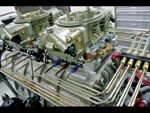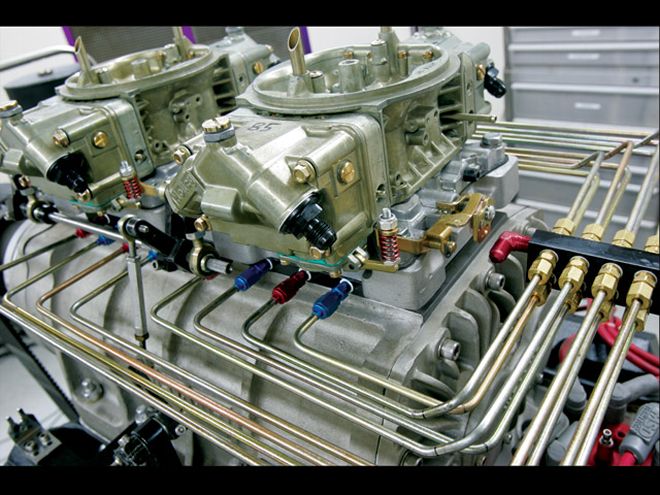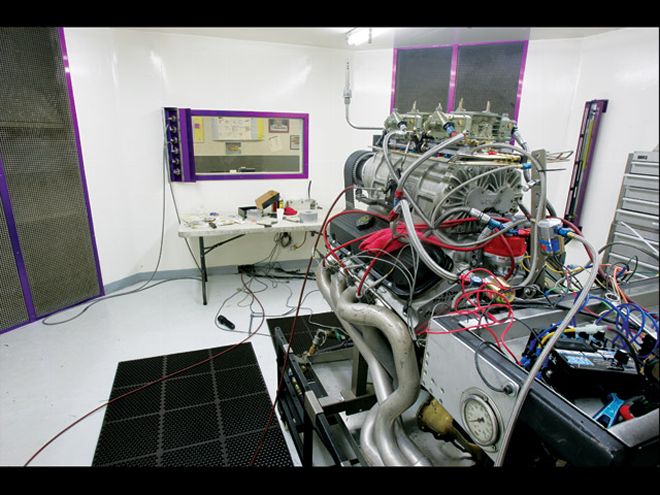
In the '80s we thought it was really stupid. Nitrous atop an 8-71 blower was the norm for every wannabe Pro Street car on the fairgrounds. Like you could ever use that, right? Well, you can. And when applied with the posture of going fast over looking cool, sprayin' a blower is gooood. Like 1,000 hp wortha good. Without even trying.

We got the idea from Jim Henn, a local Toyota Racing Development engine builder whose glaringly beige '64 Nova was found on our May '04 cover and again at HOT ROD's '04 Pump Gas Drags. The thing runs 9.80s at 138 mph with a 355ci small-block with 8.2:1 compression, a 234-at-0.050 hydraulic-roller cam, Dart Pro 1 230cc heads, and a Weiand 144ci miniblower under an NOS Big Shot plate nitrous system. There's no posing involved. The sucker works.
Remember our GM ZZ454 crate big-block that we're using for the Every Trick in the Book series? By the time the Dec. '04 issue rolled around, we had the stock long-block making 820 hp on pump gas with a Weiand 8-71 blower and a custom Comp Cams 240/240-at-0.050 solid roller. We were dying to fling the hose to it to see what kind of Jim Henn trickery we could duplicate, big-block style. So we did, using the NOS PN 02520 kit made specifically for GMC-style blowers, and here's the punch line: 1,007 hp at 6,700 rpm and 845 lb-ft at 6,000.
WHY IT'S SO COOL
Our test proved way more glorious than the power alone. Short of a turbo, the combination of a blown motor on nitrous can't be beat for ruthless speed that's truly streetable. It allows a mild camshaft for good idle quality and off-idle driveability, but the forced airflow of the huffer tends to extend the engine's rpm capability. For example, with the same camshaft, our ZZ454 makes peak power at 6,100 rpm naturally aspirated, and at 6,800 rpm blown on 8-plus pounds of boost. Therefore, you get race rpm with a street cam. You also get to do it on pump gas, with average cylinder heads, and with far less cubes than otherwise would be needed to easily hit the same power levels on pump gas. Atmospheric pressure can never compete with boost when it comes to a huge torque curve.
So that's the argument for a blower, but the typical Roots has the drawback that it's not too thrilled with extreme rpm, and the adiabatic efficiency is said to be about the worst. That means the faster you spin the blower, or the more boost you ask of it, the more heat you build. We've seen it get to the point where extra boost doesn't even make more power because the air is getting so hot. Intercooling is one answer, but nitrous is better. When nitrous oxide changes from a liquid (in the bottle) to a gas (as it exits the discharge orifice in the manifold), its temperature is minus 127 degrees F, providing an extreme cooling charge in the intake tract. Blowers like that a lot, as seen by the fact that the 175hp jetting provided in the NOS kit we used actually delivered nearly 200 hp. Also, check out the dyno charts and you'll see that we engaged the nitrous at 5,000 rpm. Below that point the engine was actually making less power than during the first test because it was later in the day and ambient temperatures were hotter and baro pressure lower, reducing the boost pressure by about half a pound, which equates to the kind of lost power that the standard temperature and pressure correction factors cannot compensate for. Power was down by about 20 hp in spots. But when the nitrous fully kicked in, the boost actually increased, partially due to the increased mass in the intake. Nitrous makes blown power more consistent regardless of atmospheric conditions.
 Our 454 combo uses a GM crate engine long-block augmented with a Milodon oil pan, a Comp Cams solid roller (240/240 at 0.050, 0.335/0.335 lobe lift, 112 LDA), Comp Hi-Tech Stainless 1.8:1 rockers, a Teflon-stripped and hard-anodized Weiand 8-71 by The Blower Shop, and a pair of out-of-the-box Holley 950 HP blower carbs. The Hooker 2 1/8-inch headers were run with 18-inch collectors and no mufflers.
Our 454 combo uses a GM crate engine long-block augmented with a Milodon oil pan, a Comp Cams solid roller (240/240 at 0.050, 0.335/0.335 lobe lift, 112 LDA), Comp Hi-Tech Stainless 1.8:1 rockers, a Teflon-stripped and hard-anodized Weiand 8-71 by The Blower Shop, and a pair of out-of-the-box Holley 950 HP blower carbs. The Hooker 2 1/8-inch headers were run with 18-inch collectors and no mufflers.
THE CURE FOR INSANITY
Nitrous on top of boost is crazy talk, right? Actually, we'll argue that it's easier on parts to make 820 blown and 1,000 on juice than it is to make 750 naturally aspirated and 1,000 on spray, which is not at all uncommon. Also, we did a few things to quell the damage potential. First, we made blown runs on Rockett Brand 93 octane, but the nitrous pulls were on VP Fuels 114 octane, just like you could do when going from street to strip. Second, we retarded the peak timing from 31 degrees blown to 26 degrees blown on nitrous. The fuel and timing change alone reduced power by 28 hp and 32 lb-ft at peak when run without the nitrous.
NOS NITROUS CONTROLLER
We also explored the magic of electronics, deploying the nitrous through an NOS progressive nitrous controller. NOS makes three different kinds of these: PN 15835, which uses a throttle position sensor to feed nitrous in proportion to throttle opening; PN 15835B ($319.95), which simply ramps up the percentage of nitrous over an adjustable period of time after the button is engaged; and the one we used, PN 15834 ($549.95), which has the ramping-up feature as well as the ability to activate the nitrous based on a time delay (for example, you set the nitrous to activate 2 seconds after the throttle switch is closed). In the test shown in our dyno chart, we set the nitrous to activate at 20 percent of the system's capacity, then ramp up to 100 percent over three seconds. Since the Superflow dyno was set to control the engine acceleration to 300 rpm per second, we were able to plot the time in seconds in the far right column, and by studying the increase in raw horsepower and percentage gain, you can see how the nitrous slowly increased to maximum output between 5,000 and 6,000 rpm.
Normally when we dyno nitrous systems we see a huge spike in power exactly when the button is hit, and it's that sudden increase in cylinder pressure (jumping from a BMEP of 214 to 270 in 300 rpm during one non-progressive nitrous test with this engine) that tears up head gaskets and breaks pistons. The NOS progressive controller takes the violence out of the hit, aiding traction and reducing breakage throughout the drivetrain. The initial hit can also be tuned for track conditions without sacrificing peak power once the car is hooked up. It's a beautiful thing.
MSD PROGRAMMABLE TIMING CONTROL
We mentioned that we retarded the ignition timing 5 degrees from 31 to 26 degrees total for nitrous use. The problem with just cranking back the distributor is that initial timing will also be retarded a like amount, and 10 degrees of initial timing makes for lazy starting and poor response. Retarded timing will also mean a loss of power at WOT before the nitrous is engaged, and while that might be a good thing for traction, there's a smarter way: digital ignition control.
The MSD ignition box that offers boost-referenced programmable timing is the Digital Programmable 7, PN 7535 ($699.95 at Summit Racing). With that box you can lock out your mechanical timing advance (easy to do with an MSD billet distributor) and set the entire curve electronically on your laptop computer. The blown-and-nitrous combo offers a number of benefits. First, the stable timing at idle can help kill blower surge, which is generally fuel related but can also be aggravated by advance weights flying in and out as the rpm climbs and falls. Second, you can map the curve to pull out timing in proportion to boost so that you can have killer idle quality and response at the low end with zero risk of detonation as the rpm and boost climbs. Alternately, you can take timing out at your dragstrip launch rpm for traction, then feed it in down track, and even pull a little back at the top end if your combo delivers more mph with less high-rpm timing. The curve can be any shape you like.
Even better, the Programmable Digital 7 has a timing-retard trigger that can be activated by the NOS Progressive Controller as soon as the nitrous is engaged. It can also be programmed to ramp the timing retard to match the rate of the nitrous controller. For example, if the nitrous ramps to 100 percent over 3 seconds, then the MSD box can retard the timing at the same rate, or a little quicker just to be safe. Trick.
SO DO IT
We're pretty sold on this setup. We honestly think you could drive it on Power Tour(tm), then click low to high 9s depending on the car's weight and the converter you feel like living with. Not that it's cheap. From carbs to oil pan including the water pump, headers, and the NOS and MSD electronics, this package whacks the daylights out of $14,000, though you could easily use these principles with cheaper used parts or with a small-block and get similarly spectacular results. Then again, it's hard to build a serious big-block from scratch for less than $10,000, and not everyone is driving around with 1,000 hp on tap.